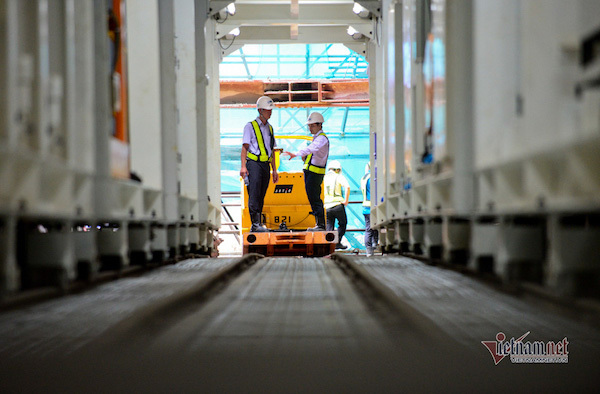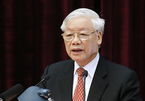This result is thanks to the Party and State’s issuance of a series of policies on economic innovation and international integration, whereby people and businesses are empowered to do business, bringing prosperity to the country. Along with that, we have made contributions to humanity.
The career that we have never had
 |
|
During a particularly difficult year with the Covid-19 pandemic, which has stirred the whole world, Vietnam's growth rate is estimated to be at about 2%, still quite good compared to many neighboring countries. Photo: Thanh Tung
|
In his recent article, General Secretary of the Communist Party of Vietnam and Vietnamese President Nguyen Phu Trong made a remarkable comment: “I have repeatedly said that, with all humility, we can still affirm: Our country has never had the career, potentiality, position and international reputation as we have today. From a small, poor, backward country, with very low education, almost no name on the world map, today Vietnam has grown to become a country with a population of nearly 100 million, a developing country of middle income, having relationships with most countries in the world, joining most international organizations and being a member, a reliable and responsible partner of the international community."
That "career" has been affirmed by many international organizations and foreign scholars under their perspective.
Mr. Hamada Kazuyuki, a Japanese politician and scholar, wrote in his book "Future Power - Redrawing the World Map in 2030": "Vietnam is currently the most prominent economy in Asia. The upper class, who can invest more than $30 million, has grown to 13% over the past five years, surpassing 10,000. At such a rate, by 2026 the growth rate of the upper class will outperform China, India, and enter the world's top list."
The World Bank two years ago made very encouraging comments: “More than 70% of Vietnamese people are secure economically, of which 13% belong to the middle class by world standards. These classes are growing rapidly, growing by more than 20% between 2010 and 2017. Since 2014, an average of 1.5 million Vietnamese people join the global middle class each year, which shows that households are continuing to climb the higher economic ladder after escaping poverty."
To date, Vietnam has established diplomatic relations with 189 out of 193 member countries of the United Nations; established a stable, long-term framework with 30 strategic and comprehensive partnerships; and implemented 13 new-generation Free Trade Agreements (FTAs) to become one of the most open economies in the world.
Economic growth has gradually improved from 6.21% in 2016, to 6.81% in 2017, 7.08% in 2018 and 7.02% in 2019. In the difficult year of Covid-19 pandemic, Vietnam's growth rate is estimated at about 2%, still quite good compared to many neighboring countries.
In its recent economic report, the World Bank noted: “Vietnam's economic outlook in the near future will face many difficulties, in the context of the global economic recession and domestic decline is worse than expected. However, Vietnam is showing a stronger resilience than most similar economies, and the medium and long-term outlook remains positive. Economic foundations have yet to be in decline, and Vietnam has the potential to benefit from current global trade, investment and production trends."
Besides the macro foundation, which has been stable in recent years, other foundations of Vietnam as mentioned above are quite clear for a more dynamic development, different from the situation of a nation exhausted by war, isolated from the international community, the vast majority of people living below the poverty line only a few decades ago.
 |
|
Compared with other successful economies in the region, Vietnam's per capita GDP growth is rather modest. Photo: Phong Anh
|
Growth has slowed
However, despite the relatively high growth rate, the average growth rate in the 2016-2020 period has slowed down to about 5.82% per year. This growth rate is the lowest compared with the average GDP growth of 7.49% per year in the period 2001-2005; 6.88% per year in the 2006-2010 period and 5.89% per year in the 2011-2015 period, according to the calculations of the Central Institute for Economic Management.
Thus, the GDP growth rate tends to recover slowly, lacks stability and is lower than the target set out in the Economic Development Strategy for 2011-2020 of 7-8% per year.
National Assembly (NA) deputy Hoang Quang Ham, Vice Chairman of the NA Finance and Budget Committee, once warned that Vietnam has taken many steps, sometimes with the growth rate that was top in the region and the world, but these were short steps, so the country still lagged behind many countries, which took slow but longer steps.
He said: "Despite the growth of 7%, reaching a high level in the region and the world, in absolute numbers, the gap is getting wider. Thirty years ago, the world average per capita income was $3,900 more than that of Vietnam. The gap has doubled to more than $8,000 and the gap is still increasing over the years."
The gap between Vietnam's per capita GDP and the world average in 2017 was about $8,300 and it was $8,400 in 2018 and $8,735 in 2019.
On the other hand, if compared to other successful regional economies such as Japan, South Korea, and Singapore, Vietnam's per capita GDP growth is quite modest. In terms of absolute scale, the Vietnamese economy tends to lag further behind the major regional economies. (Chart)
Another indicator is labor productivity. In terms of purchasing power parity (PPP) in 2011, Vietnam's labor productivity in 2017 reached $10,232, equivalent to about 7.2% of Singapore's productivity level; 18.5% of Malaysia; 36.2% of Thailand; 43% of Indonesia and 55% of the Philippines. The difference in labor productivity between Vietnam and other countries continues to increase, according to CIEM calculations.
The development space is still immense
Although national income ranks 57/193, per capita income of Vietnam ranks 123/182, according to the World Economic Forum (WEF). This means that Vietnam ranks in the group of countries at the bottom of the table with the lowest per capita income, while, with a population of 96 million, Vietnam ranks 15th in the world in terms of population.
According to the latest corruption index of Transparency International, Vietnam ranks 116/177, which means it belongs to the bottom quarter of the countries..
According to the social development index, Vietnam is not included in the table because there are not enough data. Meanwhile, according to the Quality of Life index, Vietnam has a score of 22.58, standing at 72/76, which means that it is near the bottom of the table.
According to the WHO health index, Vietnam ranks 160 out of 190 countries - in the group of countries with the worst health organization.
According to UNDP, the Human Development Index (HDI) of Vietnam ranks 118 out of 189 countries, in the middle group.
In terms of patents, according to the International Property Rights Index, Vietnam ranks 108/130 in terms of intellectual value, which means close to the bottom.
We still do not know how to make from the screws for the North-South highway, let alone inventions of a human stature. Most luxury goods and electronics have to be imported; the majority of exports is raw goods, or processed only.
These statistics show that although the people have become wealthier than before, and most of them have surpassed the poverty line, the country is still poor and the gap between Vietnam and developed countries is still wide. However, the space for the country to develop, for the people to get rich to "stand shoulder to shoulder with powers of the five continents" is still immense. That effort must be nourished in many ways, beside the flame of desire.
Tu Giang
To be continued…

The people and the ruling party's measure of value
"In all works of the Party and State, the people are always defined as the root," Party Chief and President Nguyen Phu Trong wrote in his article about the work that needs to be done for the 13th National Party Congress.

Prepare and organize the National Party Congress well, bring the country into a new stage of development
VietNamNet would like to introduce an article by Party General Secretary and President Nguyen Phu Trong, entitled “Prepare and organize the National Party Congress well, bring the country into a new stage of development".